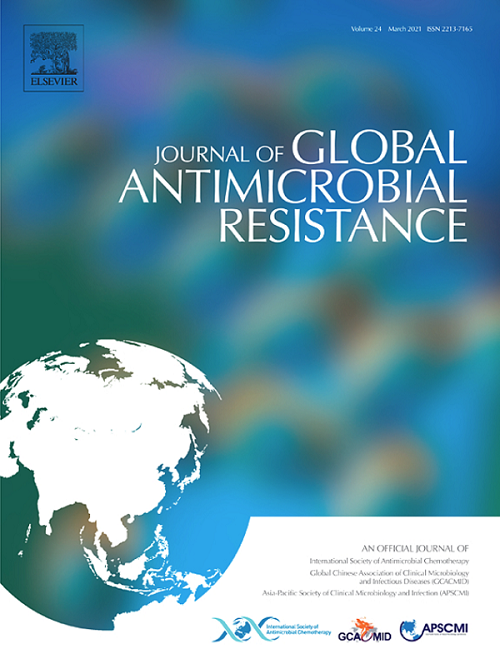携带fod的耐甲氧西林金黄色葡萄球菌ST764在东亚的传播:人类和牲畜传播的证据
IF 3.2
3区 医学
Q2 INFECTIOUS DISEASES
引用次数: 0
摘要
目的:了解耐甲氧西林金黄色葡萄球菌临床分离株fosD的流行情况及特点。方法:利用基因组测序和ResFinder对471株MRSA分离株进行fosD筛选,评估其抗菌敏感性,并进行纳米孔测序、电穿孔质粒转移、fosD分子克隆和系统发育分析。结果:广州市两所教学医院共检出471株MRSA,其中10株为ST764型fosd阳性。鉴定的磷霉素阳性菌株的MIC为16384 mg/L。该基因位于36202 bp的质粒pFOS-R1上,与日本报道的pTZ2162同源。此外,比较基因组分析表明fosD已经在多种葡萄球菌中传播,分子克隆证实fosD可以介导RN4220高水平的磷霉素抗性。系统发育分析显示来自中国、日本和泰国的ST764阳性菌株,可能提示ST764 MRSA在东亚地区的传播。我们发现的fod阳性的ST764菌株与此前报道的广州鸡群中采集到的fod阳性的ST764菌株密切相关,提示可能存在人与牲畜之间的传播。结论:携带兽疫的ST764 MRSA分离株正在东亚跨境传播,临床分离株来自中国、日本和泰国,对公共卫生构成越来越大的威胁。磷霉素在家畜中应在监督下谨慎使用。此外,应仔细监测耐甲氧西林金黄色葡萄球菌的跨境传播。本文章由计算机程序翻译,如有差异,请以英文原文为准。
Transmission of fosD-carrying methicillin-resistant Staphylococcus aureus ST764 in East Asia: Evidence of human and livestock transmission
Objectives
To investigate the prevalence and to characterise fosD in the clinical isolates of methicillin-resistant Staphylococcus aureus in China.
Methods
We screened 471 MRSA isolates for fosD using genomic sequencing and ResFinder, evaluated antimicrobial susceptibility, and performed nanopore sequencing, plasmid transfer via electroporation, molecular cloning of fosD, and phylogenetic analyses.
Results
Among 471 MRSA isolates, ten fosD-positive strains, which belonged to ST764, were identified in two teaching hospitals in Guangzhou. The MIC of fosfomycin in the identified fosD-positive strains was 16,384 mg/L. The fosD gene was located on the 36,202 bp plasmid pFOS-R1, which is homologous to pTZ2162 reported in Japan. Furthermore, comparative genomic analysis suggested that fosD has been disseminated across multiple Staphylococcus species while molecular cloning confirmed that fosD can mediate high-level fosfomycin resistance in RN4220. Phylogenetic analysis revealed fosD-positive ST764 strains from China, Japan and Thailand, which may imply the spread of ST764 MRSA in East Asia. Our fosD-positive ST764 strains were closely related to the previously reported fosD-positive ST764 strain collected from chickens in Guangzhou, implying the transmission of fosD-positive ST764 MRSA between humans and livestock.
Conclusions
fosD-carrying ST764 MRSA isolates are spreading across borders in East Asia, with clinical isolates from China, Japan, and Thailand, posing an increasing threat to public health. Fosfomycin should be prudently used under supervision in livestock. Furthermore, the cross-border spread of MRSA should be carefully monitored.
求助全文
通过发布文献求助,成功后即可免费获取论文全文。
去求助
来源期刊

Journal of global antimicrobial resistance
INFECTIOUS DISEASES-PHARMACOLOGY & PHARMACY
CiteScore
8.70
自引率
2.20%
发文量
285
审稿时长
34 weeks
期刊介绍:
The Journal of Global Antimicrobial Resistance (JGAR) is a quarterly online journal run by an international Editorial Board that focuses on the global spread of antibiotic-resistant microbes.
JGAR is a dedicated journal for all professionals working in research, health care, the environment and animal infection control, aiming to track the resistance threat worldwide and provides a single voice devoted to antimicrobial resistance (AMR).
Featuring peer-reviewed and up to date research articles, reviews, short notes and hot topics JGAR covers the key topics related to antibacterial, antiviral, antifungal and antiparasitic resistance.
 求助内容:
求助内容: 应助结果提醒方式:
应助结果提醒方式:


